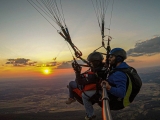When practising diving, you should consider that you need a considerable level of physical fitness to perform the activity correctly, especially taking into account that it's a sport that can be practised from the age of twelve up to very advanced ages.
This activity takes place in unstable natural environments, or in other words, the sea has highly variable conditions or situations that will require greater physical effort to move about in the aquatic environment. And it's precisely this that makes the maintenance of our physical condition and greater prior preparation necessary, which we'll rely on when conditions become more demanding.

Before heading out to sea to practise this sport, we must consider one of the main safety rules: adapting the dive profile, depth, time, location and access (from boat or shore), relevant certification, experience and the diver's personal characteristics. In short, good preparation is important – and not just regarding theoretical concepts!
Why is good preparation so important?
There are three aspects that make general physical preparation necessary to carry out our activity with greater safety and efficiency:
1. Improving general or aerobic endurance
With proper aerobic training, adaptations occur in the cardiovascular and respiratory systems. This allows us to improve the energy production process (aerobic glycolysis), necessary for moving underwater, making it more economical and reducing consumption (we become a bit like turbo-diesel engines).
Furthermore, we'll improve our lung capacity and, consequently, our apnea time, which increases safety in case of an unexpected emergency.
To develop this capacity, you can train with your preferred aerobic activity (cycling, aerobics, steps, dancing... and, of course, swimming) as long as you maintain constant intensity without breaks, and prolong the activity between 15 and 45 minutes, depending on your physical condition.

As our aerobic capacity improves, we'll increase not only the duration but also the intensity: we'll work between 50-70% of our maximum heart rate (MHR) if our condition is poor, 65-80% if it's average, and 75-85% if it's good. The maximum heart rate is calculated with a simple formula: MHR = 220 - age.
For example, if I'm 25 years old with average physical condition, I'll need to work within a heart rate range equivalent to 65-80% of my MHR, which is 220 - 25 = 195 bpm, so this range would be 127 to 156 bpm.
2. Strengthening the musculoskeletal system
How often have we complained about back discomfort? Considering we handle diving equipment that weighs between 20 and 35 kilos when dry (depending on the tank and weights in each case), we can agree that strengthening the muscles of the torso, upper limbs and waist is necessary to avoid back problems.
The abdominal muscles are essential to work on. There are hundreds of exercises, but we recommend those where the legs are bent and the waist is supported.
Similarly, it's important to work the lumbar muscles, which are antagonists to the abs. Perform the exercise as shown in the photograph, without lifting the chest too much and with slow movements.
The number of repetitions and sets again depends on your starting condition – find what's appropriate and don't forget to stretch the muscle after working it.
3. Improving specific musculature and propulsion technique
There's an undeniable relationship between technique and strength, combined with the materials used, in the effectiveness of finning and the diver's aquatic ability or agility in water.

Therefore, besides refining our technique and choosing fins that suit our ability, it's advisable to do some dry-land strengthening exercises alongside typical pool sessions.
Unlike swimming, in diving the propulsive muscles are in the lower body. Focus mainly on hip flexors and extensors, calves and tibialis muscles. Don't forget ankle mobility – with just a bit more extension your finning will become much more effective.
Postural attitude rules when handling equipment
- Always transport equipment on carts or wheeled bags and try to have the boarding area as close as possible to the club.
- Put on heavy equipment, whenever possible and conditions allow, in the water.
- This is a team or buddy sport, even when gearing up and down.
- If possible, never board the vessel while wearing your equipment.
- Correctly adjust the tank height on the jacket and choose the right size so they form a firm, compact unit with the diver.
- Learn to dive with as little weight as possible.
Conclusion
This physical conditioning programme for diving that we offer is carried out with two or three weekly sessions of approximately one hour's duration, throughout the year, varying in composition depending on the season.

We sincerely believe it will help you enjoy your dives more and better, making the wait until the next one shorter, while also helping maintain a higher quality of personal life.











